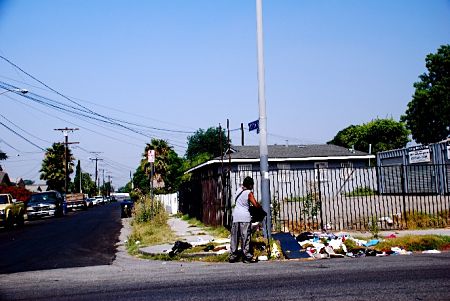
Michael Krikorian reported on the changes that have occurred in the Watts
neighborhood in South Los Angeles since the Watts Riots.
(Creative Commons Licensed)
I met with Michael Krikorian on a rainy Monday morning in Silverlake at Intelligentsia, one of the many high-end coffee shops in the Sunset Junction.
We were sitting about 15 miles away from Watts but it was evident, when he started using phrases such "Grape Street Watts Crips" and "Bounty Hunter Bloods," that Krikorian was speaking the language of another world.
Krikorian's two-part series (
part I;
part II) titled "War and Peace in Watts," was published in LA Weekly in July, 2005. Focusing on the collapse of a gang treaty that had promised peace, the article provided a snapshot of Los Angeles neighborhoods after their fall from grace.
In his opening paragraph, Krikorian summarized the problem: "President Bush keeps saying America is safer now that Saddam Hussein is out of power. Prez hasn't been to Watts lately."
The lead had less to do with the former president and more to do with the common perception of safety and the war in the streets. Of course, Watts being dangerous is no news to most people, but for a brief hiccup in its history, there was control over street violence that was maintained by the people, for the people.
In his series, Krikorian used the alternative weekly paper to talk about the disfranchised south side of Los Angeles.
The concept of not being able to walk from an area in Silverlake to a neighborhood in Echo Park would probably baffle anyone in the coffee shop where I interviewed Kirkorian, but in his article, he illustrates the realness of the divide:
"Gone are the days when a gangster from the Jordans who had a child with a lady from the Nickersons could have a lazy Sunday-afternoon barbeque in peace. 'I can't even go see my son,' says Grape Street member Dell. 'I got a baby from a girl in the Nickersons, but I can't even go there no more.'"
The peace treaty, a movement initiated by older gang members to prevent the violence from spilling over into the next generation, became official the day before the L.A. riots of 1992.
But after more than a decade of increasingly lower homicide rates, the peace began to dwindle.
"In the last year or so, as a new generation of gang members came of shooting age, which is about 13 to 16, word began to spread that the treaty was on the ropes," Krikorian wrote.
He inserted himself into Watts in 1997, when the treaty was at its height and there were only four homicides. Krikorian began his career in journalism at the Los Angeles Times as a restaurant critic and he began covering gangs on a whim, by offering to report on one of the 1997 shootings.
"The cops killed this guy "Chubby" from Grape Street, the Jordan Downs. He was on PCP slashing himself and the cops didn't want him to do that ... so they shot and killed him," Krikorian said.
"The Jordan Downs project was in an uproar and they're getting ready to riot and I was walking by the city desk and nobody wanted to go there. So I said 'I'll go,' and I went there and got the story."
That was eight years before his two-part series ran, but Krikorian cites his interest in the streets and friendships with sources as the reason why he got the story in 2005.
"You've got to love the subject and have a history with the people," he said.
Krikorian has attended neighborhood meetings, received letters from jail and spent a couple of nights embedded in Watts.
It was when a relatively harmless gang member, Dwayne "Sexy Wayne" Brooks, died that Krikorian said he knew there were shifts in the way things worked in Watts.
It is evident after reading Krikorian's stories that he is not your typical reporter who drives into a city for a homicide and disconnects with the experience, only to return to cover yet another victim of gang violence.
He knows his colors, he befriends gang leaders and he can deliver as an investigative journalist because he doesn't treat gang culture as if it is another world.
It is clear he believed, and he wanted others to understand, that the gang culture in Watts was another division of the city just like Chinatown or Little Armenia.
So he reintroduced that culture through his work in "War and Peace in Watts."
Because of the tone of the publication, he was able to add commentary on how the gang members treated him as a visitor and as a journalist.
"'The fuck you doing here? Get the fuck outta here, bitch,' booms a Grape Streeter to me as I slowly drive by. I'm in an Enterprise-rented black Chevy Aveo with doors so flimsy one burst from a Kalashnikov would turn them into Emmenthaler Swiss cheese. 'Hello, officer,' says another, which for years has been a common nighttime greeting to me in Watts."
Both in the series and in our interview he told stories of how members of the community, including gang members and motel managers, tried to encouraged him to leave.
Krikorian brings up names of gangsters to this day, usually nicknames given to them by their gangs, and he puts on his pirate smile.
"My favorite gangster was Big Evil. I would talk to him and ask him what he did that day and he would say that he didn't do much. Later on I'd find out that he killed someone two hours before I saw him," Krikorian said.
He still gets mail from Big Evil and can easily talk about the current events in Evil's family as if it were his own.
Krikorian's series immersed readers in Sexy Dwayne's neighborhood and showed what led to his death.
In a way, "War and Peace in Watts" was an obituary, telling the story of a peace that once lived and is now gone.
Spanning from 1992 to 2005, the peace treaty saw highs and eventually reached its lowest point. Krikorian guides the reader through it all by allowing the people of Watts to speak for themselves.




